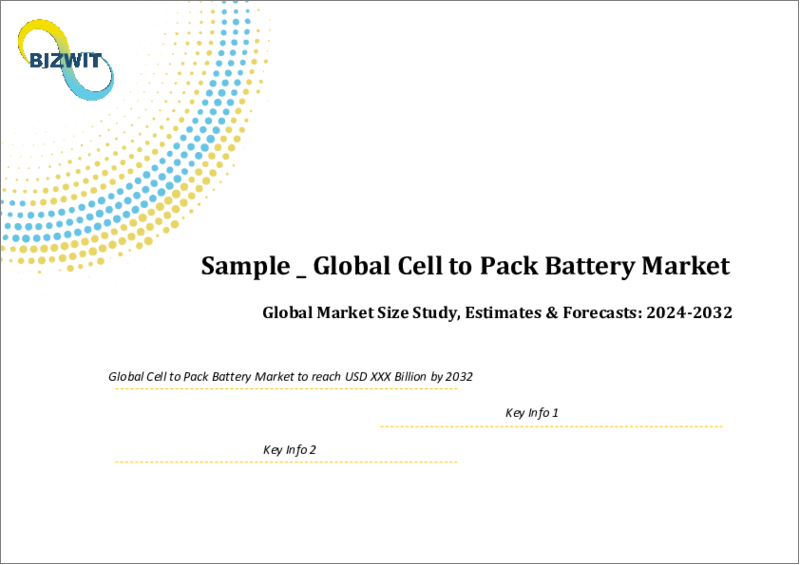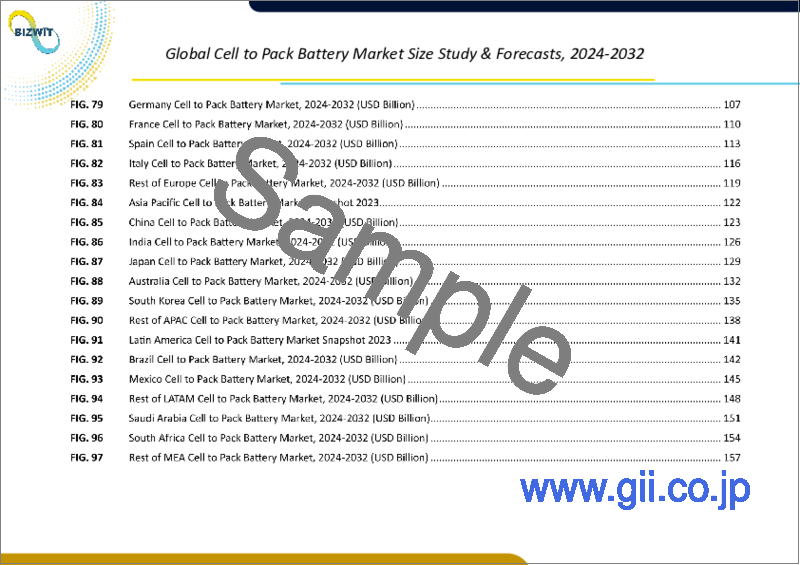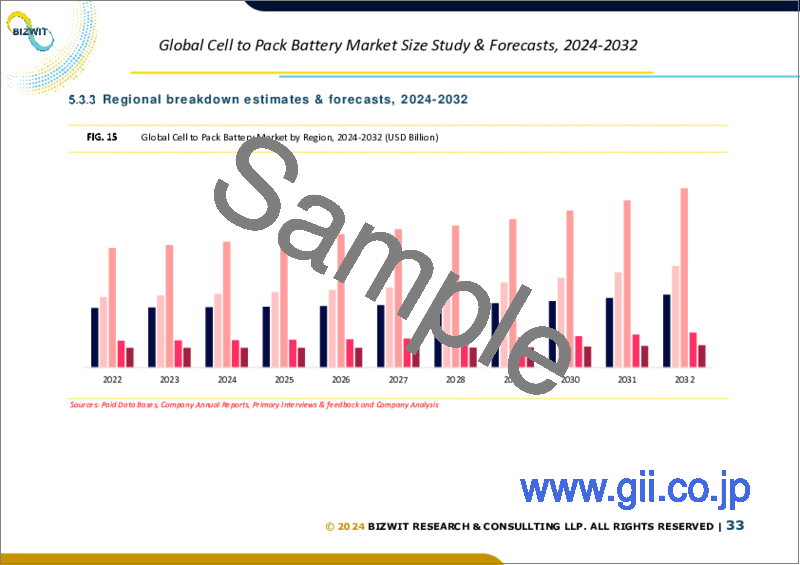|
|
市場調査レポート
商品コード
1514838
CTP (Cell to Pack) 電池の世界市場規模調査:形態別、電池タイプ別、コンポーネント別、車両タイプ別、推進タイプ別、地域別、2022年~2032年の予測Global Cell to Pack Battery Market Size study, by Forms, by Battery Type, by Components, by Vehicle Type, by Propulsion Type and Regional Forecasts 2022-2032 |
||||||
カスタマイズ可能
|
|||||||
| CTP (Cell to Pack) 電池の世界市場規模調査:形態別、電池タイプ別、コンポーネント別、車両タイプ別、推進タイプ別、地域別、2022年~2032年の予測 |
|
出版日: 2024年07月11日
発行: Bizwit Research & Consulting LLP
ページ情報: 英文 200 Pages
納期: 2~3営業日
|
全表示
- 概要
- 目次
世界のCTP (Cell to Pack) 電池市場は、2023年に約122億4,000万米ドルと評価され、予測期間2024~2032年には12.1%以上の健全な成長率で成長すると予測されています。
CTP (Cell to Pack) 電池技術は、電気自動車(EV)用電池設計の最先端アプローチであり、従来のモジュール・レベルを排除して構造を合理化します。従来の電池システムでは、まず個々のセルをモジュールにまとめ、それを電池パック全体に組み立てていました。この多段階の組み立て工程は、電池システムに重量、体積、複雑さを加えます。一方、CTP技術では、モジュールを形成する中間工程を経ることなく、セルを直接電池パックに組み込みます。この革新的なアプローチは、エネルギー密度の向上、熱管理の改善、製造コストの削減など、いくつかの利点をもたらします、
CTP (Cell to Pack) 技術の主な目的は、バッテリーパックのコストを下げ、体積密度を高めることです。従来の電池パックとは異なり、CTP (Cell to Pack) 技術は電池セルを直接パックに統合し、中間段階としてモジュールを必要としないため、電池モールドとシステムの体積エネルギー密度が向上します。電気自動車の普及率の上昇と、クリーンでグリーンな輸送を促進する政府の有利な規制が、CTP (Cell to Pack) ・バッテリー市場の成長を促進する主な要因です。しかし、CTP (Cell to Pack) 生産技術の高コストとそれに伴う安全性の懸念が市場開拓の妨げになる可能性があります。さらに、CTP (Cell to Pack) アーキテクチャの継続的な技術進歩と電池材料加工施設の増加が、これらの課題に対処し、予測期間中に市場に有利な機会を創出する可能性があります。
CTP (Cell to Pack) 電池市場の調査で考慮した主な地域には、アジア太平洋地域、北米、欧州、中南米、その他欧州が含まれます。2023年には、アジア太平洋地域が最大の市場シェアを占めています。これは、生産の中心地であり、原材料の主要な供給元であることに加え、電気自動車の採用が急増していること、政府の取り組みが好意的であることが背景にあります。主要市場プレイヤーの投資が生産能力を高め、CTP (Cell to Pack) 電池市場におけるアジア諸国の存在感を強めています。一方、北米は、特に米国エネルギー省が2022年に電気自動車と電気グリッド用の電池の国内製造を拡大するために28億米ドルを投資するなど、重要な資金調達イニシアティブによって、南北アメリカにおける生産施設の増加と政府の奨励によって推進され、最も速い成長を記録すると予測されています。さらに、南北アメリカ全域でエレクトロモビリティが拡大していることが、市場規模をさらに拡大しています。
目次
第1章 CTP (Cell to Pack) 電池の世界市場エグゼクティブサマリー
- CTP (Cell to Pack) 電池の世界市場規模・予測(2022-2032年)
- 地域別概要
- セグメント別概要
- 形態別
- 電池タイプ別
- コンポーネント別
- 車両タイプ別
- 推進力タイプ別
- 主要動向
- 景気後退の影響
- アナリストの結論・提言
第2章 世界のCTP (Cell to Pack) 電池市場の定義と調査前提条件
- 調査目的
- 市場定義
- 調査前提条件
- 包含と除外
- 制限事項
- 供給サイドの分析
- 入手可能性
- インフラ
- 規制環境
- 市場競争
- 経済性(消費者の視点)
- 需要サイド分析
- 規制の枠組み
- 技術の進歩
- 環境への配慮
- 消費者の意識と受容
- 調査手法
- 調査対象年
- 通貨換算レート
第3章 世界のCTP (Cell to Pack) 電池市場力学
- 市場促進要因
- 電気自動車の普及拡大
- 有利な政府規制
- 電池アーキテクチャの技術進歩
- 市場の課題
- 高い生産コスト
- 安全性への懸念と故障問題
- 市場機会
- 電池材料加工の拡大
- 生産設備への投資
- 欧州メーカーとアジアメーカーの提携
第4章 世界のCTP (Cell to Pack) 電池市場産業分析
- ポーターのファイブフォースモデル
- 供給企業の交渉力
- 買い手の交渉力
- 新規参入業者の脅威
- 代替品の脅威
- 競争企業間の敵対関係
- ポーターのファイブフォースモデルへの未来的アプローチ
- ポーターのファイブフォースの影響分析
- PESTEL分析
- 政治
- 経済
- 社会
- 技術
- 環境
- 法律
- 主な投資機会
- 主要成功戦略
- 破壊的動向
- 業界専門家の視点
- アナリストの結論・提言
第5章 CTP (Cell to Pack) 電池の世界市場規模と予測:形態別、2022年~2032年
- セグメントダッシュボード
- CTP (Cell to Pack) 電池の世界市場:収益動向分析、2022年・2032年
- 円筒形
- パウチ
- 角型
第6章CTP (Cell to Pack) 電池の世界市場規模と予測:電池タイプ別、2022年~2032年
- セグメントダッシュボード
- CTP (Cell to Pack) 電池の世界市場:収益動向分析、2022年・2032年
- 鉛酸
- リチウムイオン(Li-Ion)
- リチウム硫黄(Li-S)
- ニッケルマンガンコバルト(NMC)
- ニッケル水素(Ni-MH)
第7章 CTP (Cell to Pack) 電池の世界市場規模と予測:コンポーネント別、2022年~2032年
- セグメントダッシュボード
- CTP (Cell to Pack) 電池の世界市場:収益動向分析、2022年・2032年
- バッテリー管理システム
- セル
- 冷却液
- ハウジング
- スイッチ&ヒューズ
第8章 CTP (Cell to Pack) 電池の世界市場規模と予測:車両タイプ別、2022年~2032年
- セグメントダッシュボード
- CTP (Cell to Pack) 電池の世界市場:収益動向分析、2022年・2032年
- 商用車
- 乗用車
第9章 CTP (Cell to Pack) 電池の世界市場規模と予測:推進タイプ別、2022年~2032年
- セグメントダッシュボード
- CTP (Cell to Pack) 電池の世界市場:収益動向分析、2022年・2032年
- バッテリー電気自動車(BEV)
- プラグインハイブリッド車(PHEV)
第10章 CTP (Cell to Pack) 電池の世界市場規模と予測:地域別、2022年~2032年
- 北米
- 米国
- カナダ
- 欧州
- 英国
- ドイツ
- フランス
- スペイン
- イタリア
- その他欧州
- アジア太平洋
- 中国
- インド
- 日本
- オーストラリア
- 韓国
- その他アジア太平洋
- ラテンアメリカ
- ブラジル
- メキシコ
- その他ラテンアメリカ
- 中東・アフリカ
- サウジアラビア
- 南アフリカ
- その他中東とアフリカ
第11章 競合情報
- 主要企業のSWOT分析
- 主要市場戦略
- 企業プロファイル
- BYD Motors Inc.
- 主要情報
- 概要
- 財務(データの入手可能性によります)
- 製品概要
- Market Strategies
- LG Energy Solution Ltd.
- Samsung SDI Co., Ltd.
- Panasonic Industry Co., Ltd.
- SK Innovation Co., Ltd.
- Microvast Holdings, Inc.
- Nissan Motor Co., Ltd.
- Proterra Inc.
- Amperex Technology Limited
- NEC Corporation
- Hitachi Chemical Co., Ltd.
- EVE Energy Co., Ltd.
- Murata Manufacturing Co., Ltd.
- Sony Corporation
- Toshiba Corporation
- BYD Motors Inc.
第12章 調査プロセス
- 調査プロセス
- データマイニング
- 分析
- 市場推定
- 検証
- 出版
- 調査属性
The Global Cell to Pack Battery Market is valued approximately at USD 12.24 billion in 2023 and is anticipated to grow with a healthy growth rate of more than 12.1% over the forecast period 2024-2032. Cell to Pack (CTP) battery technology is a cutting-edge approach to electric vehicle (EV) battery design that streamlines the structure by removing the traditional module level. In conventional battery systems, individual cells are first grouped into modules, which are then assembled into the overall battery pack. This multi-step assembly process adds weight, volume, and complexity to the battery system. CTP technology, on the other hand, integrates the cells directly into the battery pack without the intermediate step of forming modules. This innovative approach results in several advantages, including higher energy density, improved thermal management, and reduced manufacturing costs,
The primary objectives of cell to pack technology are to lower the cost of battery packs and boost their volumetric density. Unlike traditional battery packs, cell to pack techniques integrate battery cells directly into a pack without needing modules as an intermediary step, enhancing the volumetric energy density of the battery mold and system. The rising adoption of electric vehicles and favorable government regulations promoting clean and green transportation are key factors driving the cell to pack battery market growth. However, the high cost of cell to pack production technologies and associated safety concerns may hamper market development. Moreover, ongoing technological advancements in cell to pack architecture and the rise in battery material processing facilities may address these challenges and create lucrative opportunities for the market in the forecast period.
Key regions considered for the Cell to Pack Battery Market study include Asia Pacific, North America, Europe, Latin America, and Rest of the World. In 2023, The Asia-Pacific region holds the largest market share due to its position as a production hub and major supplier of raw materials, coupled with the surging adoption of electric vehicles and favorable government initiatives. Investment from major market players is boosting production capabilities, thereby strengthening the prominence of Asian countries in the cell to pack battery market. On the other hand, North America is projected to registered fastest growth propelled by the increasing production facilities and government encouragement in the Americas, particularly with significant funding initiatives like the USD 2.8 billion investment by the U.S. Department of Energy in 2022 to expand domestic manufacturing of batteries for electric vehicles and the electric grid. Additionally, the escalating electromobility across American regions has further enhanced the market scope.
Major market players included in this report are:
- BYD Motors Inc.
- LG Energy Solution Ltd.
- Samsung SDI Co., Ltd.
- Panasonic Industry Co., Ltd.
- SK Innovation Co., Ltd.
- Microvast Holdings, Inc.
- Nissan Motor Co., Ltd.
- Proterra Inc.
- Amperex Technology Limited
- NEC Corporation
- Hitachi Chemical Co., Ltd.
- EVE Energy Co., Ltd.
- Murata Manufacturing Co., Ltd.
- Sony Corporation
- Toshiba Corporation
The detailed segments and sub-segment of the market are explained below:
By Forms:
- Cylindrical
- Pouch
- Prismatic
By Battery Type:
- Lead-Acid
- Lithium Ion (Li-Ion)
- Lithium Sulphur (Li-S)
- Nickel Manganese Cobalt (NMC)
- Nickel Metal Hydride (Ni-MH)
By Components:
- Battery Management System
- Cell
- Coolant
- Housing
- Switches & Fuses
By Vehicle Type:
- Commercial Vehicles
- Passenger Cars
By Propulsion Type:
- Battery Electric Vehicles (BEVs)
- Plug-in Hybrid Electric Vehicles (PHEVs)
By Region:
- North America
- U.S.
- Canada
- Europe
- UK
- Germany
- France
- Spain
- Italy
- ROE
- Asia Pacific
- China
- India
- Japan
- Australia
- South Korea
- RoAPAC
- Latin America
- Brazil
- Mexico
- Middle East & Africa
- Saudi Arabia
- South Africa
- RoMEA
Years considered for the study are as follows:
- Historical year - 2022
- Base year - 2023
- Forecast period - 2024 to 2032
Key Takeaways:
- Market Estimates & Forecast for 10 years from 2022 to 2032.
- Annualized revenues and regional level analysis for each market segment.
- Detailed analysis of geographical landscape with Country level analysis of major regions.
- Competitive landscape with information on major players in the market.
- Analysis of key business strategies and recommendations on future market approach.
- Analysis of competitive structure of the market.
- Demand side and supply side analysis of the market.
Table of Contents
Chapter 1. Global Cell to Pack Battery Market Executive Summary
- 1.1. Global Cell to Pack Battery Market Size & Forecast (2022- 2032)
- 1.2. Regional Summary
- 1.3. Segmental Summary
- 1.3.1. By Forms
- 1.3.2. By Battery Type
- 1.3.3. By Components
- 1.3.4. By Vehicle Type
- 1.3.5. By Propulsion Type
- 1.4. Key Trends
- 1.5. Recession Impact
- 1.6. Analyst Recommendation & Conclusion
Chapter 2. Global Cell to Pack Battery Market Definition and Research Assumptions
- 2.1. Research Objective
- 2.2. Market Definition
- 2.3. Research Assumptions
- 2.3.1. Inclusion & Exclusion
- 2.3.2. Limitations
- 2.3.3. Supply Side Analysis
- 2.3.3.1. Availability
- 2.3.3.2. Infrastructure
- 2.3.3.3. Regulatory Environment
- 2.3.3.4. Market Competition
- 2.3.3.5. Economic Viability (Consumer's Perspective)
- 2.3.4. Demand Side Analysis
- 2.3.4.1. Regulatory frameworks
- 2.3.4.2. Technological Advancements
- 2.3.4.3. Environmental Considerations
- 2.3.4.4. Consumer Awareness & Acceptance
- 2.4. Estimation Methodology
- 2.5. Years Considered for the Study
- 2.6. Currency Conversion Rates
Chapter 3. Global Cell to Pack Battery Market Dynamics
- 3.1. Market Drivers
- 3.1.1. Rising Adoption of Electric Vehicles
- 3.1.2. Favorable Government Regulations
- 3.1.3. Technological Advancements in Battery Architecture
- 3.2. Market Challenges
- 3.2.1. High Production Costs
- 3.2.2. Safety Concerns and Failure Issues
- 3.3. Market Opportunities
- 3.3.1. Expansion in Battery Material Processing
- 3.3.2. Investments in Production Facilities
- 3.3.3. Collaborations Between European and Asian Manufacturers
Chapter 4. Global Cell to Pack Battery Market Industry Analysis
- 4.1. Porter's 5 Force Model
- 4.1.1. Bargaining Power of Suppliers
- 4.1.2. Bargaining Power of Buyers
- 4.1.3. Threat of New Entrants
- 4.1.4. Threat of Substitutes
- 4.1.5. Competitive Rivalry
- 4.1.6. Futuristic Approach to Porter's 5 Force Model
- 4.1.7. Porter's 5 Force Impact Analysis
- 4.2. PESTEL Analysis
- 4.2.1. Political
- 4.2.2. Economical
- 4.2.3. Social
- 4.2.4. Technological
- 4.2.5. Environmental
- 4.2.6. Legal
- 4.3. Top investment opportunity
- 4.4. Top winning strategies
- 4.5. Disruptive Trends
- 4.6. Industry Expert Perspective
- 4.7. Analyst Recommendation & Conclusion
Chapter 5. Global Cell to Pack Battery Market Size & Forecasts by Forms 2022-2032
- 5.1. Segment Dashboard
- 5.2. Global Cell to Pack Battery Market: Forms Revenue Trend Analysis, 2022 & 2032 (USD Billion)
- 5.2.1. Cylindrical
- 5.2.2. Pouch
- 5.2.3. Prismatic
Chapter 6. Global Cell to Pack Battery Market Size & Forecasts by Battery Type 2022-2032
- 6.1. Segment Dashboard
- 6.2. Global Cell to Pack Battery Market: Battery Type Revenue Trend Analysis, 2022 & 2032 (USD Billion)
- 6.2.1. Lead-Acid
- 6.2.2. Lithium Ion (Li-Ion)
- 6.2.3. Lithium Sulphur (Li-S)
- 6.2.4. Nickel Manganese Cobalt (NMC)
- 6.2.5. Nickel Metal Hydride (Ni-MH)
Chapter 7. Global Cell to Pack Battery Market Size & Forecasts by Components 2022-2032
- 7.1. Segment Dashboard
- 7.2. Global Cell to Pack Battery Market: Components Revenue Trend Analysis, 2022 & 2032 (USD Billion)
- 7.2.1. Battery Management System
- 7.2.2. Cell
- 7.2.3. Coolant
- 7.2.4. Housing
- 7.2.5. Switches & Fuses
Chapter 8. Global Cell to Pack Battery Market Size & Forecasts by Vehicle Type 2022-2032
- 8.1. Segment Dashboard
- 8.2. Global Cell to Pack Battery Market: Vehicle Type Revenue Trend Analysis, 2022 & 2032 (USD Billion)
- 8.2.1. Commercial Vehicles
- 8.2.2. Passenger Cars
Chapter 9. Global Cell to Pack Battery Market Size & Forecasts by Propulsion Type 2022-2032
- 9.1. Segment Dashboard
- 9.2. Global Cell to Pack Battery Market: Propulsion Type Revenue Trend Analysis, 2022 & 2032 (USD Billion)
- 9.2.1. Battery Electric Vehicles (BEVs)
- 9.2.2. Plug-in Hybrid Electric Vehicles (PHEVs)
Chapter 10. Global Cell to Pack Battery Market Size & Forecasts by Region 2022-2032
- 10.1. North America Cell to Pack Battery Market
- 10.1.1. U.S. Cell to Pack Battery Market
- 10.1.1.1. Forms breakdown size & forecasts, 2022-2032
- 10.1.1.2. Battery Type breakdown size & forecasts, 2022-2032
- 10.1.1.3. Components breakdown size & forecasts, 2022-2032
- 10.1.1.4. Vehicle Type breakdown size & forecasts, 2022-2032
- 10.1.1.5. Propulsion Type breakdown size & forecasts, 2022-2032
- 10.1.2. Canada Cell to Pack Battery Market
- 10.1.1. U.S. Cell to Pack Battery Market
- 10.2. Europe Cell to Pack Battery Market
- 10.2.1. U.K. Cell to Pack Battery Market
- 10.2.2. Germany Cell to Pack Battery Market
- 10.2.3. France Cell to Pack Battery Market
- 10.2.4. Spain Cell to Pack Battery Market
- 10.2.5. Italy Cell to Pack Battery Market
- 10.2.6. Rest of Europe Cell to Pack Battery Market
- 10.3. Asia-Pacific Cell to Pack Battery Market
- 10.3.1. China Cell to Pack Battery Market
- 10.3.2. India Cell to Pack Battery Market
- 10.3.3. Japan Cell to Pack Battery Market
- 10.3.4. Australia Cell to Pack Battery Market
- 10.3.5. South Korea Cell to Pack Battery Market
- 10.3.6. Rest of Asia Pacific Cell to Pack Battery Market
- 10.4. Latin America Cell to Pack Battery Market
- 10.4.1. Brazil Cell to Pack Battery Market
- 10.4.2. Mexico Cell to Pack Battery Market
- 10.4.3. Rest of Latin America Cell to Pack Battery Market
- 10.5. Middle East & Africa Cell to Pack Battery Market
- 10.5.1. Saudi Arabia Cell to Pack Battery Market
- 10.5.2. South Africa Cell to Pack Battery Market
- 10.5.3. Rest of Middle East & Africa Cell to Pack Battery Market
Chapter 11. Competitive Intelligence
- 11.1. Key Company SWOT Analysis
- 11.2. Top Market Strategies
- 11.3. Company Profiles
- 11.3.1. BYD Motors Inc.
- 11.3.1.1. Key Information
- 11.3.1.2. Overview
- 11.3.1.3. Financial (Subject to Data Availability)
- 11.3.1.4. Product Summary
- 11.3.2. Market Strategies
- 11.3.3. LG Energy Solution Ltd.
- 11.3.4 Samsung SDI Co., Ltd.
- 11.3.5 Panasonic Industry Co., Ltd.
- 11.3.6 SK Innovation Co., Ltd.
- 11.3.6 Microvast Holdings, Inc.
- 11.3.7 Nissan Motor Co., Ltd.
- 11.3.8 Proterra Inc.
- 11.3.9 Amperex Technology Limited
- 11.3.10 NEC Corporation
- 10.3.11 Hitachi Chemical Co., Ltd.
- 10.3.12 EVE Energy Co., Ltd.
- 10.3.13 Murata Manufacturing Co., Ltd.
- 10.3.14 Sony Corporation
- 10.3.15 Toshiba Corporation
- 11.3.1. BYD Motors Inc.
Chapter 12. Research Process
- 12.1. Research Process
- 12.1.1. Data Mining
- 12.1.2. Analysis
- 12.1.3. Market Estimation
- 12.1.4. Validation
- 12.1.5. Publishing
- 12.2. Research Attributes





